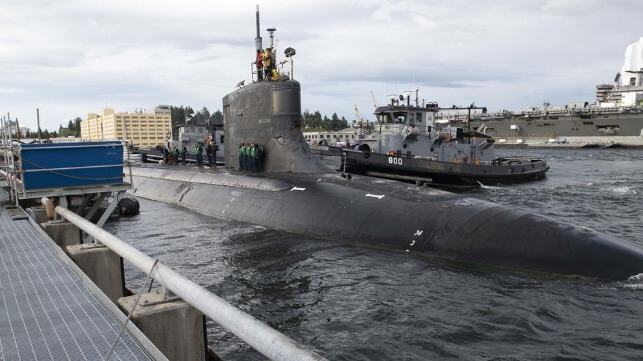CSSC Researchers Claim to Track Fast-Moving Submarines From Above

A team of Chinese researchers claims to have found a way to track even the stealthiest attack-sub designs in the U.S. Navy, depending on their speed.
A new study of real-world surface data by Li Yuhang and the 713th Research Institute of China State Shipbuilding Corporation claims that subs moving faster than 20 knots could produce miniscule ripples on the surface of the ocean - undetectable by the human eye, but potentially trackable using ultra-high-resolution radar. This "surface wake" phenomenon has been known for decades, but until recently has been considered unusable (at least in an unclassified setting) because the submarine's surface disturbances are so minute compared to the motion of the waves. Li's study claimed to rely on real-world data from Chinese-operated sensors in the South China Sea, a hotbed of U.S. Navy submarine activity.
The study could have implications for America's stealthiest assets. In October 2021, the Seawolf-class attack sub USS Connecticut was under way in the South China Sea when it hit an uncharted underwater seamount. The sub was badly damaged and was forced to return to Guam for emergency repairs; eleven crewmembers were injured. A subsequent investigation faulted the crew for going too fast in unfamiliar waters. The accident inquiry's final report disclosed that USS Connecticut was under way at 24 knots, in excess of the 20-knot threshhold described by Li's study.
Li's team also claimed that their approach could detect a sub moving as slowly as two knots, which could create difficulty for attack subs loitering under the surface or preparing to strike.
The study builds on recent Chinese announcements of novel wake-detection technology using ultra-high-frequency radar in the 6G spectrum range (terahertz). Terahertz frequency waves have a length measuring as little as 1/10,000 of a meter, making them potentially suitable for detecting submillimeter-sized ripples on the ocean's surface. However, terahertz technology is exceptionally challenging to employ, requiring highly specialized equipment to transmit and receive signals while filtering out background noise. The data received would also have to be analyzed to distinguish tiny ripples from all other surface motion - a task that would be virtually impossible in the past, but may now be closer to reality because of AI.
It is possible that the U.S. Navy possesses a system capable of producing the same results, though its specifications are classified. The AN/APS-154 Advanced Airborne Sensor (AAS) is a giant two-sided AESA radar pod designed to mount on the belly of a P-8A Poseidon maritime patrol aircraft; its exact capabilities are not public, but it is known that the system is designed for photo-like resolution in all weather. The P-8A's core function is anti-submarine warfare, and previous Navy guidance has suggested plans to use AESA radar in combination with other technology to spot subs from aloft.
